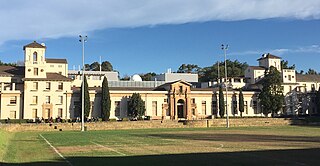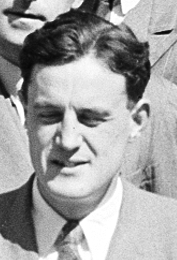
Altair is the brightest star in the constellation of Aquila and the twelfth-brightest star in the night sky. It has the Bayer designation Alpha Aquilae, which is Latinised from α Aquilae and abbreviated Alpha Aql or α Aql. Altair is an A-type main-sequence star with an apparent visual magnitude of 0.77 and is one of the vertices of the Summer Triangle asterism; the other two vertices are marked by Deneb and Vega. It is located at a distance of 16.7 light-years from the Sun. Altair is currently in the G-cloud—a nearby interstellar cloud, an accumulation of gas and dust.

Radio astronomy is a subfield of astronomy that studies celestial objects at radio frequencies. The first detection of radio waves from an astronomical object was in 1933, when Karl Jansky at Bell Telephone Laboratories reported radiation coming from the Milky Way. Subsequent observations have identified a number of different sources of radio emission. These include stars and galaxies, as well as entirely new classes of objects, such as radio galaxies, quasars, pulsars, and masers. The discovery of the cosmic microwave background radiation, regarded as evidence for the Big Bang theory, was made through radio astronomy.

Jodrell Bank Observatory in Cheshire, England hosts a number of radio telescopes as part of the Jodrell Bank Centre for Astrophysics at the University of Manchester. The observatory was established in 1945 by Bernard Lovell, a radio astronomer at the university, to investigate cosmic rays after his work on radar in the Second World War. It has since played an important role in the research of meteoroids, quasars, pulsars, masers, and gravitational lenses, and was heavily involved with the tracking of space probes at the start of the Space Age.

Sir Alfred Charles Bernard Lovell was an English physicist and radio astronomer. He was the first director of Jodrell Bank Observatory, from 1945 to 1980.

Sir Martin Ryle was an English radio astronomer who developed revolutionary radio telescope systems and used them for accurate location and imaging of weak radio sources. In 1946 Ryle and Derek Vonberg were the first people to publish interferometric astronomical measurements at radio wavelengths. With improved equipment, Ryle observed the most distant known galaxies in the universe at that time. He was the first Professor of Radio Astronomy in the University of Cambridge and founding director of the Mullard Radio Astronomy Observatory. He was the twelfth Astronomer Royal from 1972 to 1982. Ryle and Antony Hewish shared the Nobel Prize for Physics in 1974, the first Nobel prize awarded in recognition of astronomical research. In the 1970s, Ryle turned the greater part of his attention from astronomy to social and political issues which he considered to be more urgent.

John Gatenby Bolton was a British-Australian astronomer who was fundamental to the development of radio astronomy. In particular, Bolton was integral in establishing that discrete radio sources were either galaxies or the remnants of supernovae, rather than stars. He also played a significant role in the discovery of quasars and the centre of the Milky Way. Bolton served as the inaugural director of the Parkes radio telescope in Australia and established the Owens Valley Radio Observatory in California. Bolton's students held directorships at most of the radio observatories in the world and one was a Nobel Prize winner. Bolton is considered a key figure in the development of astronomy in Australia.
Aperture synthesis or synthesis imaging is a type of interferometry that mixes signals from a collection of telescopes to produce images having the same angular resolution as an instrument the size of the entire collection. At each separation and orientation, the lobe-pattern of the interferometer produces an output which is one component of the Fourier transform of the spatial distribution of the brightness of the observed object. The image of the source is produced from these measurements. Astronomical interferometers are commonly used for high-resolution optical, infrared, submillimetre and radio astronomy observations. For example, the Event Horizon Telescope project derived the first image of a black hole using aperture synthesis.
The Eddington Medal is awarded by the Royal Astronomical Society for investigations of outstanding merit in theoretical astrophysics. It is named after Sir Arthur Eddington. First awarded in 1953, the frequency of the prize has varied over the years, at times being every one, two or three years. Since 2013 it has been awarded annually.
In physics, the Hanbury Brown and Twiss (HBT) effect is any of a variety of correlation and anti-correlation effects in the intensities received by two detectors from a beam of particles. HBT effects can generally be attributed to the wave–particle duality of the beam, and the results of a given experiment depend on whether the beam is composed of fermions or bosons. Devices which use the effect are commonly called intensity interferometers and were originally used in astronomy, although they are also heavily used in the field of quantum optics.
The Narrabri Stellar Intensity Interferometer (NSII) was the first astronomical instrument to measure the diameters of a large number of stars at visible wavelengths. It was designed by Robert Hanbury Brown, who received the Hughes Medal in 1971 for this work. It was built by University of Sydney School of Physics and was located near the town of Narrabri in north-central New South Wales, Australia. Many of the components were constructed in the UK. The design was based on an earlier optical intensity interferometer built by Hanbury Brown and Richard Q. Twiss at Jodrell Bank in the UK. Whilst the original device had a maximum baseline of 10m, the NSII device consisted of a large circular track that allowed the detectors to be separated from 10 to 188m. The NSII operated from 1963 until 1974, and was used to measure the angular diameters of 32 stars.

The Paul Wild Observatory, also known as the Narrabri Observatory and Culgoora Observatory, is an astronomical research facility located about 24 km west of Narrabri, New South Wales, Australia. It is the home of the Australia Telescope Compact Array, and the Culgoora Solar Observatory.
Richard Quintin Twiss was a British astronomer. He is known for his work on the Hanbury Brown and Twiss effect with Robert Hanbury Brown. It led to the development of the Hanbury Brown-Twiss intensity interferometer in the UK in 1954. Their work appeared to contradict the established beliefs about quantum interference, and he and Brown received the Eddington Medal of the Royal Astronomical Society for it in 1968.
An intensity interferometer is the name given to devices that use the Hanbury Brown and Twiss effect. In astronomy, the most common use of such an astronomical interferometer is to determine the apparent angular diameter of a radio source or star. If the distance to the object can then be determined by parallax or some other method, the physical diameter of the star can then be inferred. An example of an optical intensity interferometer is the Narrabri Stellar Intensity Interferometer. In quantum optics, some devices which take advantage of correlation and anti-correlation effects in beams of photons might be said to be intensity interferometers, although the term is usually reserved for observatories.
Roger Clifton Jennison worked as a radio astronomer at Jodrell Bank under the guidance of Robert Hanbury Brown. Jennison made a number of discoveries in the field of radio astronomy, including the discovery of the double nature of radio source Cygnus A with M K Das Gupta and the mapping of Cassiopeia A with V Latham.
Edward George "Taffy" Bowen, CBE, FRS, was a Welsh physicist who made a major contribution to the development of radar. He was also an early radio astronomer, playing a key role in the establishment of radioastronomy in Australia and the United States.

Joseph Lade Pawsey was an Australian scientist, radiophysicist and radio astronomer.

Aruvankadu is a big village located in The Nilgiris District, Tamil Nadu, India. It is located between Coonoor and Ooty on the NH 67, 6 km from Coonoor town and 12 km from Ooty. It is connected by frequent bus services from various towns and cities. Aruvankadu is also connected via the Nigiri Mountain Railway (NMR).
In optical astronomy, interferometry is used to combine signals from two or more telescopes to obtain measurements with higher resolution than could be obtained with either telescopes individually. This technique is the basis for astronomical interferometer arrays, which can make measurements of very small astronomical objects if the telescopes are spread out over a wide area. If a large number of telescopes are used a picture can be produced which has resolution similar to a single telescope with the diameter of the combined spread of telescopes. These include radio telescope arrays such as VLA, VLBI, SMA, astronomical optical interferometer arrays such as COAST, NPOI and IOTA, resulting in the highest resolution optical images ever achieved in astronomy. The VLT Interferometer is expected to produce its first images using aperture synthesis soon, followed by other interferometers such as the CHARA array and the Magdalena Ridge Observatory Interferometer which may consist of up to 10 optical telescopes. If outrigger telescopes are built at the Keck Interferometer, it will also become capable of interferometric imaging.

The School of Physics is a constituent body of the Faculty of Science at the University of Sydney, Australia.










